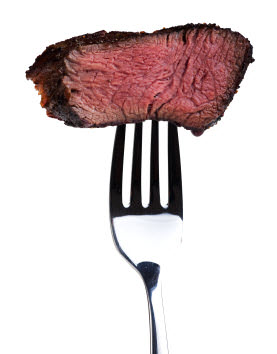
Updated 8/11/17
It has been happening slowly but steadily. What began as “this is a good thing to do,” has now become, “this is good.” First I had to convince Mark, the big steak guy. “Isn’t it leaner and tougher?” he asked warily. But it wasn’t and we agreed, this is good.
 I’m talking about buying grass-fed beef instead of the industrially produced stuff you get in the supermarket.
I’m talking about buying grass-fed beef instead of the industrially produced stuff you get in the supermarket.
We’re fortunate in Bucks County to have several sources of pasture-raised beef, fed no antibiotics or hormones, munching only on various kinds of grasses and raised pretty much organically.
I’ve learned a lot about meat since then, talking to grass-fed beef farmers like Henry and Charlotte Rosenberger of Tussock Sedge Farm in Blooming Glen, Nevada Mease of Meadow Brook Farms in Springtown, and pork farmers Joanna and Marc Michini of Purely Farm in Pipersville (see our previous post). At area farmers’ markets you’ll also find nearby grass-fed cattle farmers like Dennis and Carol Dorney of Naturally@Holben Valley Farm who sell at the Wrightstown Farmers Market.
Good for us, good for the animal
But why buy grass-fed beef, especially if it costs more? There are several reasons, and if it means we eat meat a little less, well so be it. (Although truth be told, we’re still eating a good amount).
Let’s start with health reasons. A 2010 study published in the Nutrition Journal, showed that grass-fed animal products are higher in beta carotene (Vitamin A), conjugated linoleic acid (CLA), and Omega-3 fatty acids, which are important in reducing cholesterol, diabetes, cancer, high blood pressure and other life threatening diseases.
Grass-fed beef is lower in fat, cholesterol and calories. Another benefit is the absence of antibiotics and growth hormones, used extensively by industrial cattle operations.
 Grazing on pasture is also better for the animals. It’s the way nature intended them to live. Cattle were designed to walk and eat at the same time, and to eat grasses and plants. Not grain. Cattle are not genetically built to digest large amounts of grain, but those raised in CAFOs (Concentrated Animal Feeding Operations – doesn’t that sound appetizing?) are fed a steady diet of corn and soy to fatten them up faster. In addition, research by the USDA has shown that cattle switched from grain-based diets to hay were less likely to shed harmful E. coli.
Grazing on pasture is also better for the animals. It’s the way nature intended them to live. Cattle were designed to walk and eat at the same time, and to eat grasses and plants. Not grain. Cattle are not genetically built to digest large amounts of grain, but those raised in CAFOs (Concentrated Animal Feeding Operations – doesn’t that sound appetizing?) are fed a steady diet of corn and soy to fatten them up faster. In addition, research by the USDA has shown that cattle switched from grain-based diets to hay were less likely to shed harmful E. coli.
Henry Rosenberger once told me that when he was feeding his cattle grain in the winter, the weights of the newly born calves was so high that he almost always had to call a veterinarian in to help with difficult births.
Once he stopped feeding them grain, the calves’ weights returned to normal. Now the cows don’t need any help at all. Henry comes out in the morning and finds the new calf nursing by its mother.
Jessica Moore learned all this too, and decided that her family was going all grass-fed. But being a busy, working mom, she wanted the convenience of buying in larger quantities. Why not eliminate one less thing from the shopping list? She did research, met local cattle farmers, made sure they were raising the animals right (no antibiotics, no growth stimulants, free range and 100% grass-fed) and proceeded to buy a whole cow.
Three years ago she started Philly CowShare, a business enabling consumers to buy grass-fed meat in larger quantities for convenience and ease (now a part of From the Farmer, a delivered-to-your-door food service.)
“We have treated beef like a commodity in this country, and it always tastes the same. Americans get distracted by fat, as if that is the taste of meat.”
Beef as a commodity
 The meat is raised well, that’s for sure. But it also tastes good.
The meat is raised well, that’s for sure. But it also tastes good.
“We have treated beef like a commodity in this country,” says Moore, “and it always tastes the same.” Americans get distracted by fat, as if that is the taste of meat.
“But it is more like cheese. Different parts of the world create different kinds of cheeses, and the same goes for beef,” she says. You need to understand genetics, Moore explains, and it’s very different for grass-fed beef.
Tenderness is about the genetics and the timing – knowing when it’s time for the cow to go to slaughter. As these farmers mature, she explains, there will be more talk about the taste profile of the meat, more talk about the taste of the grass. “We’ll have more sophisticated language to describe the taste of the meat.”
So why does it cost more?
One final note on cost – the reason many people give for not buying grass-fed beef more often. With industrially raised cattle, the animals are sent to market at 14 – 16 months after having been fattened up with grains and hormones. Fed grains like corn, which are heavily subsidized by the US government.
Grass-fed cows take 18-20 months to mature for slaughter – and their feed is not subsidized by the US government. More hay, more fuel, more work on the part of the farmers over a longer period of time. But in the end you have to decide which is best for you and your family.
The American Grassfed Association has a good website to learn more about pasture-raised animals, including an informative Meat Terminology Primer. Check out your local farmers’ market too or contact the farms mentioned above directly. Good eating!
Where to get your grass-fed meat in Bucks County
Want to know where to get pasture-raised meat in Bucks County? See our post, Where’s the beef? And pork, and lamb, and chicken…
Updated 8/11/17

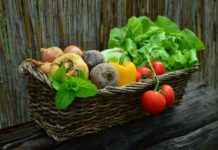


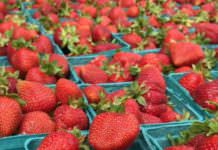
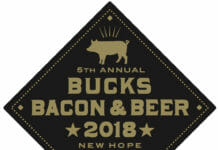


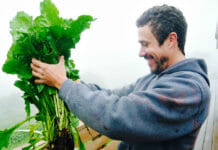
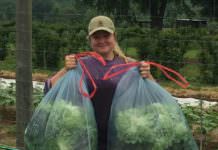
![What we’re reading [Oct 16 2017]](https://www.buckscountytaste.com/wp-content/uploads/2017/10/coffee_macbook_reading_pexels-photo-414630-218x150.jpeg)
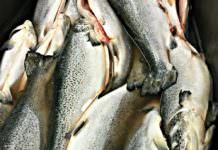
Cows are big. Share one. http://t.co/N5AytEZKh0
RT @BCTaste: Cows are big. Share one.: What’s all this about grass-fed beef? #BucksCounty #grassfedbeef #localfood http://t.co/N5AytEZKh0
Barbara A Rambo liked this on Facebook.
Traci Townsend liked this on Facebook.
Cows are big. Share one.: What’s all this about grass-fed beef? #BucksCounty #grassfedbeef #localfood http://t.co/cV4FGzdhYx
Where to buy local, grass-fed beef in #BucksCounty & #Philadelphia http://t.co/gRyYMZ4tIz
#LocalFood #Sustainable #health RT @BCTaste: Where to buy local, grass-fed beef in #BucksCounty & #Philadelphia http://t.co/yTcwWIzrdX
RT @BCTaste: Where to buy local, grass-fed beef in #BucksCounty & #Philadelphia http://t.co/gRyYMZ4tIz
RT @BCTaste: Cows are big. Share one.: What’s all this about grass-fed beef? #BucksCounty #grassfedbeef #localfood http://t.co/N5AytEZKh0
RT @BCTaste: Where to buy local, grass-fed beef in #BucksCounty & #Philadelphia http://t.co/gRyYMZ4tIz
Lynne, thanks for a well-crafted article promoting better tasting beef and better-for-you eating. Growing up on a small farm north of Allentown, I recall fondly when my Mother would “share a steer” with a few other friends. Grass-fed cattle were raised on a neighbor’s farm literally across the street from ours. As a young boy I was found standing at the fence talking to the bovines soon to be my family’s food. Magically a large box would appear in our kitchen with neatly packed white-paper bundles of beef. pure deliciousness that filled our freezer and fed our family for many meals. Yes, grass fed is naturally better for both the cattle and for us!
Thanks, Joe!
Do you have any information on Kosher grass fed beef?
[…] and delicious. We have several posts explaining what’s the big deal with grass-fed beef here. Below, check out some farms that have different cuts of meat, perfect for the foodie that loves to […]